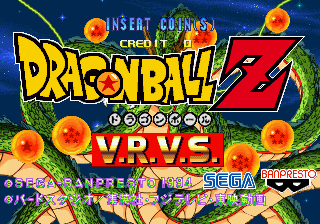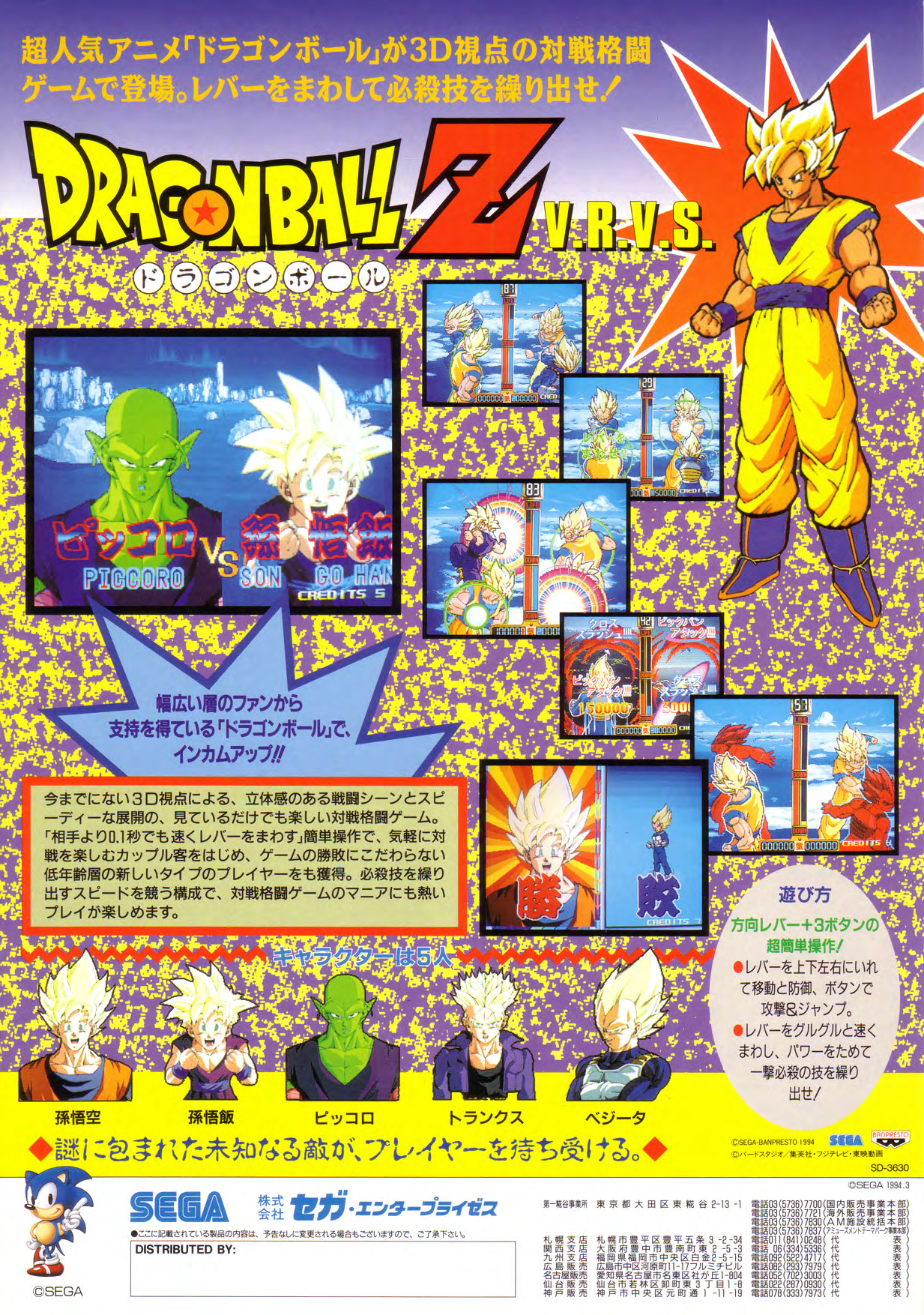Difference between revisions of "Dragon Ball Z V.R.V.S."
From Sega Retro
m (Text replacement - "{{fileref\|EGM US 0([1-9][0-9])\.pdf\|page=(.*)}}" to "{{magref|egm|$1|$2}}") |
|||
| (14 intermediate revisions by 6 users not shown) | |||
| Line 2: | Line 2: | ||
| bobscreen=DBZVRVS System32 Title.png | | bobscreen=DBZVRVS System32 Title.png | ||
| publisher=[[Sega]] | | publisher=[[Sega]] | ||
| − | | developer=[[Sega AM3]], [[Banpresto]] | + | | developer=[[Sega AM3]],{{fileref|Sega Arcade History JP EnterBrain Book-1.pdf|page=131}} [[Sega AM4]], [[Banpresto]] |
| + | | licensor=Bird Studio, [[Shueisha]], [[Fuji TV]], [[Toei Douga]] | ||
| system=[[Sega System 32]] | | system=[[Sega System 32]] | ||
| − | |||
| sounddriver= | | sounddriver= | ||
| peripherals= | | peripherals= | ||
| Line 10: | Line 10: | ||
| genre=Fighting | | genre=Fighting | ||
| releases={{releasesArcade | | releases={{releasesArcade | ||
| − | | sys32_date_jp= | + | | sys32_date_jp=1994-03{{fileref|Sega Arcade History JP EnterBrain Book-1.pdf|page=131}} |
}} | }} | ||
}} | }} | ||
| − | {{stub}}'''''{{PAGENAME}}''''' is a third-person fighting game based on the ''[[wikipedia:Dragon Ball Z|Dragon Ball Z]]'' franchise, and was released for [[Sega System 32]] arcade hardware exclusively in Japan. The cabinet features motion sensors, meaning it can be played by physically punching and kicking in a similar manner to the [[Sega Activator]]. | + | {{stub}}'''''{{PAGENAME}}''''' is a third-person fighting game based on the ''[[wikipedia:Dragon Ball Z|Dragon Ball Z]]'' franchise, and was released for [[Sega System 32]] arcade hardware exclusively in Japan. The cabinet features motion sensors, meaning it can be played by physically punching and kicking in a similar manner to the [[Sega Activator]]. The project was originally conceived to be a 4-player game at [[Joypolis]]{{ref|1=https://twitter.com/Hiro_H10th/status/1336980162999590912}}, then using the title '''''Dragon Ball Z VR Battle'''''.{{magref|harmony|122|5}} |
==Gameplay== | ==Gameplay== | ||
| − | Although the game uses 2D sprites, it uses third-person, over-the-shoulder camera angles positioned behind the characters along with sprite scaling to create a 3D-like experience. The game is controlled with a | + | Although the game uses 2D sprites, it uses third-person, over-the-shoulder camera angles positioned behind the characters along with sprite scaling to create a 3D-like experience. The game is controlled with a joystick and 3 buttons, while a deluxe edition of the game features motion sensors that allow the player to move his or her body to control the character in the game. |
| − | The technology used was similar to that of the Sega Activator peripheral for the Mega Drive console, but with extra sensors to pull off better reaction sensing. This was thus the first successful example of full-body motion sensing in a video game. | + | The technology used was similar to that of the [[Sega Activator]] peripheral for the Mega Drive console, but with extra sensors to pull off better reaction sensing. This was thus the first successful example of full-body motion sensing in a video game. |
===Playable characters=== | ===Playable characters=== | ||
| Line 32: | Line 32: | ||
===Legacy=== | ===Legacy=== | ||
| − | A modified version of ''Dragon Ball Z V.R.V.S.'' was at one point set for release on the 3DO as ''Dragon Ball Z: Cell to Kogeki Da'', | + | A modified version of ''Dragon Ball Z V.R.V.S.'' was at one point set for release on the 3DO as ''Dragon Ball Z: Cell to Kogeki Da''{{ref|https://www.kamisama.com.br/3do-dragon-ball-z-cell-to-kogeki-da/}}; however, the project was ultimately scrapped. It is unknown if Sega had any involvement in this conversion. |
==Production credits== | ==Production credits== | ||
| − | {{ | + | {{mainArticle|{{PAGENAME}}/Production credits}} |
| − | {{ | ||
| − | |||
| − | |||
| − | |||
| − | |||
| − | |||
| − | |||
| − | |||
| − | |||
| − | |||
| − | |||
| − | }} | ||
==Magazine articles== | ==Magazine articles== | ||
| Line 56: | Line 44: | ||
|{{gitem|DBZVRVS System32 JP Flyer.jpg|JP flyer}} | |{{gitem|DBZVRVS System32 JP Flyer.jpg|JP flyer}} | ||
}} | }} | ||
| + | |||
| + | ==Photo gallery== | ||
| + | <gallery> | ||
| + | Dragon Ball Z V.R.V.S. cabinet.jpg|[[Amusement Machine Show 1993]] | ||
| + | </gallery> | ||
==Physical scans== | ==Physical scans== | ||
Latest revision as of 13:59, 12 February 2024
| Dragon Ball Z V.R.V.S. | |||||||||
|---|---|---|---|---|---|---|---|---|---|
| System(s): Sega System 32 | |||||||||
| Publisher: Sega | |||||||||
| Developer: Sega AM3,[1] Sega AM4, Banpresto | |||||||||
| Licensor: Bird Studio, Shueisha, Fuji TV, Toei Douga | |||||||||
| Genre: Fighting | |||||||||
| Number of players: 1-2 | |||||||||
|
This short article is in need of work. You can help Sega Retro by adding to it.
Dragon Ball Z V.R.V.S. is a third-person fighting game based on the Dragon Ball Z franchise, and was released for Sega System 32 arcade hardware exclusively in Japan. The cabinet features motion sensors, meaning it can be played by physically punching and kicking in a similar manner to the Sega Activator. The project was originally conceived to be a 4-player game at Joypolis[2], then using the title Dragon Ball Z VR Battle.[3]
Contents
Gameplay
Although the game uses 2D sprites, it uses third-person, over-the-shoulder camera angles positioned behind the characters along with sprite scaling to create a 3D-like experience. The game is controlled with a joystick and 3 buttons, while a deluxe edition of the game features motion sensors that allow the player to move his or her body to control the character in the game.
The technology used was similar to that of the Sega Activator peripheral for the Mega Drive console, but with extra sensors to pull off better reaction sensing. This was thus the first successful example of full-body motion sensing in a video game.
Playable characters
- Son Goku
- Piccolo
- Vegeta
- Son Gohan
- Trunks
History
Reception
The game was well-received upon its original debut at the Amusement Machine Show 1993. It was praised for its accurate motion detection and fun gameplay, and was popular with the crowd at the show.[4][5]
Legacy
A modified version of Dragon Ball Z V.R.V.S. was at one point set for release on the 3DO as Dragon Ball Z: Cell to Kogeki Da[6]; however, the project was ultimately scrapped. It is unknown if Sega had any involvement in this conversion.
Production credits
- Main article: Dragon Ball Z V.R.V.S./Production credits.
Magazine articles
- Main article: Dragon Ball Z V.R.V.S./Magazine articles.
Promotional material
Photo gallery
Physical scans
| System 32, JP | ||||
|---|---|---|---|---|
References
- ↑ 1.0 1.1 Sega Arcade History, Enterbrain, page 131
- ↑ @Hiro_H10th on Twitter
- ↑ Harmony, "1993 9-10" (JP; 1993-10-01), page 5
- ↑ Edge, "November 1993" (UK; 1993-09-30), page 17
- ↑ Electronic Gaming Monthly, "October 1993" (US; 1993-xx-xx), page 222
- ↑ https://www.kamisama.com.br/3do-dragon-ball-z-cell-to-kogeki-da/
| Dragon Ball Z games for Sega systems | |
|---|---|
| Dragon Ball Z V.R.V.S. (1994) | |
| Dragon Ball Z: Buyuu Retsuden (1994) | |
| Dragon Ball Z: Shinbutouden (1995) | Dragon Ball Z Idainaru Dragon Ball Densetsu (1996) | |
| Unlicensed Dragon Ball Z games for Sega systems | |
| Dragon Ball: Final Bout (1998) | |



